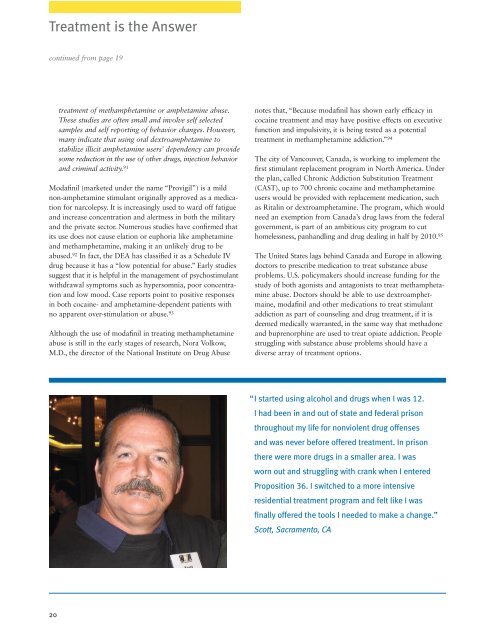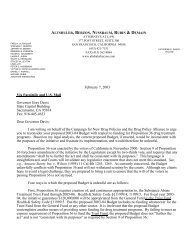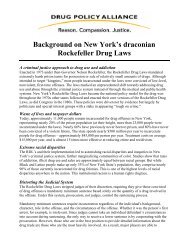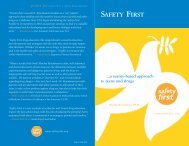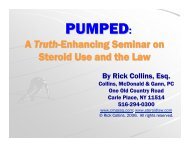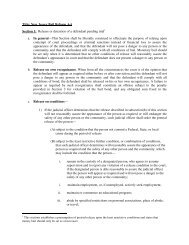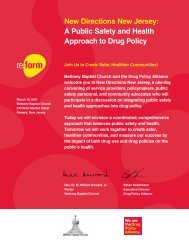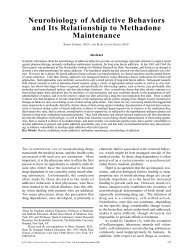A Four Pillars Approach to Methamphetamine - Drug Policy Alliance
A Four Pillars Approach to Methamphetamine - Drug Policy Alliance
A Four Pillars Approach to Methamphetamine - Drug Policy Alliance
You also want an ePaper? Increase the reach of your titles
YUMPU automatically turns print PDFs into web optimized ePapers that Google loves.
Treatment is the Answer<br />
continued from page 19<br />
treatment of methamphetamine or amphetamine abuse.<br />
These studies are often small and involve self selected<br />
samples and self reporting of behavior changes. However,<br />
many indicate that using oral dextroamphetamine <strong>to</strong><br />
stabilize illicit amphetamine users’ dependency can provide<br />
some reduction in the use of other drugs, injection behavior<br />
and criminal activity. 91<br />
Modafinil (marketed under the name “Provigil”) is a mild<br />
non-amphetamine stimulant originally approved as a medication<br />
for narcolepsy. It is increasingly used <strong>to</strong> ward off fatigue<br />
and increase concentration and alertness in both the military<br />
and the private sec<strong>to</strong>r. Numerous studies have confirmed that<br />
its use does not cause elation or euphoria like amphetamine<br />
and methamphetamine, making it an unlikely drug <strong>to</strong> be<br />
abused. 92 In fact, the DEA has classified it as a Schedule IV<br />
drug because it has a “low potential for abuse.” Early studies<br />
suggest that it is helpful in the management of psychostimulant<br />
withdrawal symp<strong>to</strong>ms such as hypersomnia, poor concentration<br />
and low mood. Case reports point <strong>to</strong> positive responses<br />
in both cocaine- and amphetamine-dependent patients with<br />
no apparent over-stimulation or abuse. 93<br />
Although the use of modafinil in treating methamphetamine<br />
abuse is still in the early stages of research, Nora Volkow,<br />
M.D., the direc<strong>to</strong>r of the National Institute on <strong>Drug</strong> Abuse<br />
notes that, “Because modafinil has shown early efficacy in<br />
cocaine treatment and may have positive effects on executive<br />
function and impulsivity, it is being tested as a potential<br />
treatment in methamphetamine addiction.” 94<br />
The city of Vancouver, Canada, is working <strong>to</strong> implement the<br />
first stimulant replacement program in North America. Under<br />
the plan, called Chronic Addiction Substitution Treatment<br />
(CAST), up <strong>to</strong> 700 chronic cocaine and methamphetamine<br />
users would be provided with replacement medication, such<br />
as Ritalin or dextroamphetamine. The program, which would<br />
need an exemption from Canada’s drug laws from the federal<br />
government, is part of an ambitious city program <strong>to</strong> cut<br />
homelessness, panhandling and drug dealing in half by 2010. 95<br />
The United States lags behind Canada and Europe in allowing<br />
doc<strong>to</strong>rs <strong>to</strong> prescribe medication <strong>to</strong> treat substance abuse<br />
problems. U.S. policymakers should increase funding for the<br />
study of both agonists and antagonists <strong>to</strong> treat methamphetamine<br />
abuse. Doc<strong>to</strong>rs should be able <strong>to</strong> use dextroamphetmaine,<br />
modafinil and other medications <strong>to</strong> treat stimulant<br />
addiction as part of counseling and drug treatment, if it is<br />
deemed medically warranted, in the same way that methadone<br />
and buprenorphine are used <strong>to</strong> treat opiate addiction. People<br />
struggling with substance abuse problems should have a<br />
diverse array of treatment options.<br />
“I started using alcohol and drugs when I was 12.<br />
I had been in and out of state and federal prison<br />
throughout my life for nonviolent drug offenses<br />
and was never before offered treatment. In prison<br />
there were more drugs in a smaller area. I was<br />
worn out and struggling with crank when I entered<br />
Proposition 36. I switched <strong>to</strong> a more intensive<br />
residential treatment program and felt like I was<br />
finally offered the <strong>to</strong>ols I needed <strong>to</strong> make a change.”<br />
Scott, Sacramen<strong>to</strong>, CA<br />
20


